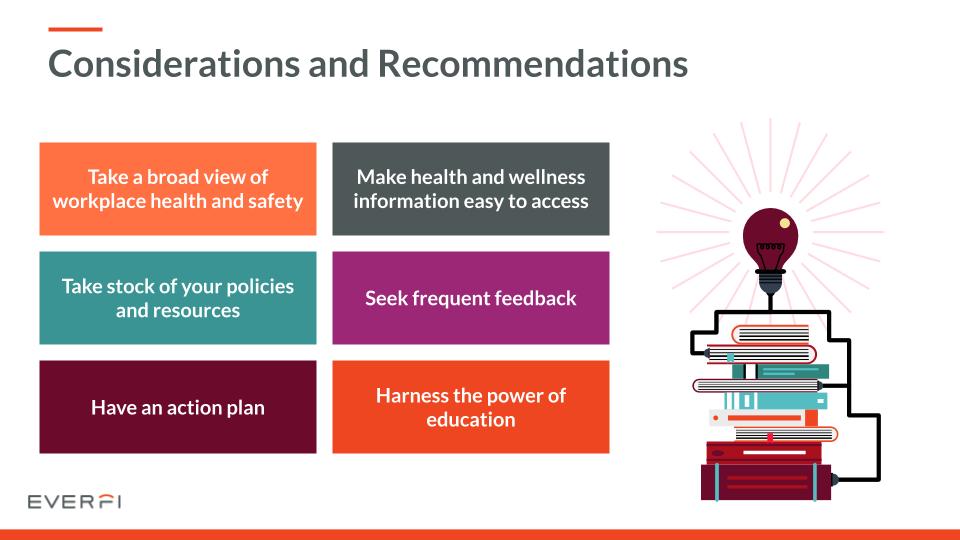As we enter 2021 and reflect on the previous year, there’s no denying that 2020 was an incredibly challenging year — for employees, for organizations, and for communities. If you had asked corporate leaders before what was at the top of their worry list, surely a pandemic wasn’t it. The confluence of COVID-19, extreme financial and economic disruption, the deep and widespread impact of racial injustice, and a dramatic increase in mental health needs due to all of the above, has left employers searching for guidance and solutions to changing work environments. Therefore, we’ve compiled these six tips to help you navigate a changing work environment:
- Take a broad view of workplace health and safety
- Make health and wellness information easy to access
- Take stock of your policies and resources
- Seek frequent feedback
- Have an action plan
- Harness the power of education

A recent study conducted by the Society for Human Resource Management (SHRM) found that 34% of employers surveyed did not have an emergency preparedness plan prior to the COVID-19 pandemic. Compounding this:
- Over 70% of employers report that they are struggling to adapt to remote work,
- 7 out of 10 say that maintaining employee morale is a challenge, and
- Two-thirds of employees have reported experiencing symptoms of depression at least “sometimes.”
The workplace will never be the same, even after COVID-19 has passed. Employers and employees will continue to address changes in work environments by prioritizing physical and mental health and safety. This may lead employers to reimagine workspaces, gatherings, benefits programs, and illness prevention and wellness. Employers will be expected to keep talking about, and educating employees, on how to stay safe and healthy, and how to work effectively remotely on a regular basis — a trend that is likely here to stay. And, as more and more organizations make remote work a part of their long term plan, the field will become even more competitive with recruiting and retaining top talent because distance will no longer be a barrier.
Address Changing Work Environments Now and in the Future
1. Take a broad view of workplace health and safety
Given the array of challenges, risks, and needs in today’s changing work environments, organizations need to take a broader view of workplace health and safety, and business continuity, than we have in the past. This involves moving away from a narrower focus on injuries and illnesses to one that includes employee wellness, psychological safety, and interpersonal conflicts that can lead to hostility or violence. To manage change in the workplace, employer plans should address newer issues that are critical to sustaining our workforce, such as employee mental wellbeing, how to work and connect effectively in a remote environment, and how to prevent, de-escalate, and address harassment and other conflicts in this new work environment.
2. Make employee health and wellness information easy to access
Recent data from the Kaiser Family Foundation revealed that, in June 2020, 36.5% of American adults reported experiencing symptoms of anxiety or depression. For those employees who are balancing work, families, their physical and mental health, and navigating life in a pandemic, time is of the essence–and spending time sifting through emails or chat threads to find critical wellness-related information is not ideal. Support your employees and workplace culture by making health and wellness related information as easy to access as possible. This may include having a resource document that is displayed through your HR information system, creating a dedicated internal website for health and wellness information, or creating a resource guide that employees can bookmark. You can also use programs, like EVERFI’s newest resource Staying Healthy in a Changing Environment to communicate such information.
3. Take stock of your policies and resources
Take some time to review your organization’s policies and procedures to ensure that they reflect changes in work environments and workplace practices, and anticipate future needs. Ask yourself, have we articulated all of our cleaning, safety, and exposure reporting protocols clearly for all employees? Do we need to revisit our mental wellness benefits offerings, our policies for workplace accommodations, or our resources related to remote work? Also, be sure to confirm that your anti-harassment policy makes it clear that it applies equally in digital environments and provides examples of online harassment.
Webinar: Staying Healthy in a Changing Work Environment
4. Seek frequent feedback
Navigating a pandemic is something that is entirely new and, as such, most employers are learning as they go. A crucial part of managing change in the workplace, assessing needs, and measuring success is obtaining employee feedback. This may include pulse surveys that are sent out to your team members on a scheduled basis, qualitative conversations with employees, and focus groups. Most importantly, use the insights that you glean to inform your return to work strategy — and communicate those efforts back to employees so they know that their perspectives are making a difference.
5. Have an action plan
Experts agree that whether you are returning to the workplace or preparing your employees for long-term remote work— or both — it is important to create a detailed return to work plan. You can find some templates from SHRM or the law firm of Covington & Burling that are helpful for the return to work context; for those organizations that will be primarily remote for some time, there’s a helpful article on Medium with a lot of great tips. The crux of these plans involves ensuring that employers revisit current (or create new) policies and procedures, establish communication channels, provide workplace training on all of the above, and help employees adapt to changing work environments.
6. Harness the power of education
Workplace training is a critical element for helping employees navigate a rapidly changing work environment. Educating employees on new safety protocols, effective techniques for working remotely, ethical conduct expectations, and resources to support their mental wellbeing provides them with the tools to both be safe and feel safe. Through education, employers can help their employees adapt to changes in the workplace and feel supported, thus driving morale and engagement, and improving workplace culture.

